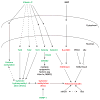Epigenetics of cellular reprogramming
- PMID: 23948105
- PMCID: PMC4359361
- DOI: 10.1016/j.gde.2013.06.005
Epigenetics of cellular reprogramming
Abstract
Cells are constantly changing their state of equilibrium in response to internal and external stimuli. These changes in cell identity are driven by highly coordinated modulation of gene expression. This coordinated regulation is achieved in large part due to changes in the structure and composition of the chromatin, driven by epigenetic modulators. Recent discoveries in cellular and genomic reprogramming have highlighted the importance of chromatin modifications to reach and uphold the fidelity of target cell states. In this review, we focus on the latest work addressing the mechanisms surrounding the epigenetic regulation of various types of reprogramming, including somatic cell nuclear transfer (SCNT), cell fusion and transcription factor-induced and microRNA-induced pluripotency. The studies covered herein showcase the interplay between these epigenetic pathways, and highlight the importance of furthering our understanding of these connections to form a clearer picture of the mechanisms underlying stable cell fate transitions.
Copyright © 2013 Elsevier Ltd. All rights reserved.
Figures



References
-
- Lin J, Shi L, Zhang M, Yang H, Qin Y, Zhang J, Gong D, Zhang X, Li D, Li J. Defects in trophoblast cell lineage account for the impaired in vivo development of cloned embryos generated by somatic nuclear transfer. Cell Stem Cell. 2011;8:371–375. - PubMed
-
- Chan MM, Smith ZD, Egli D, Regev A, Meissner A. Mouse ooplasm confers context-specific reprogramming capacity. Nat Genet. 2012;44:978–980. This study compares DNA methylation of the genome following fertilization and SCNT, and identifies certain loci that are demethylated after fertilization but resistant to demethylation during SCNT. - PMC - PubMed
Publication types
MeSH terms
Substances
Grants and funding
LinkOut - more resources
Full Text Sources
Other Literature Sources

